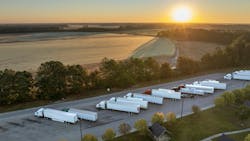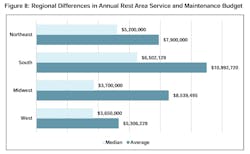Parking scarcity is one of the most significant challenges facing the trucking industry today. It is no surprise, then, that truck parking was the focus of the American Transportation Research Institute’s most recent study.
The research group worked with 47 states and performed independent research to break down data behind the makeup, cost, and funding of public rest stop parking specifically. Despite the cost, the value of truck parking is immense.
“It’s not just a convenience for truck drivers. It’s not just staging for the e-commerce packages we buy daily,” Dan Murray, SVP at ATRI, told FleetOwner. “It’s assisting the driver to be compliant with federal laws and assisting the driver to minimize fatigue while driving.”
ATRI's latest study examines which states are pursuing public parking, how much public parking costs, federal funding opportunities, and more.
Public rest areas vs private truck stops
The group’s most recent study focuses on truck parking available at public rest areas. Public rest areas tend to have fewer amenities, while private parking lots provide extensive services.
Previous ATRI research found that drivers overwhelmingly prefer to stop at private truck stops over rest areas. However, public rest areas still provide essential parking spaces for drivers.
“As I move into my longer hours-of-service requirements … the services and amenities that I get at a private truck stop make perfect sense,” Murray said. “But for 30-minute rest breaks, for bathroom breaks and some overnight stays, public rest areas are critically important.”
How common are rest areas across the U.S?
The cost of insufficient parking
Truck parking availability is primarily a safety concern, but parking scarcity also negatively impacts driver efficiency.
In its 2016 research on parking, ATRI found that drivers on average parked 56 minutes before their hours-of-service limits to find adequate parking. The data suggests that searching for available parking wastes roughly 9,300 revenue-earning miles per driver each year, costing the driver roughly $7,000 in income annually.
“He could have basically run another 56 minutes a day but didn’t,” Murray said. “That is considerable and it’s one of the reasons why truck parking has been the number one issue for truck drivers in the last five years.”
Most U.S. truck parking belongs to private truck stops. Of the 313,000 truck parking spaces tracked by the Federal Highway Administration in 2020, 273,000 (87%) were private, while the remaining 40,000 belonged to public rest areas.
“Today, there’s approximately one public truck parking space for every four private truck stop spaces, and that seems to be a good ratio generally,” Murray said.
The report measured the public-to-private truck parking ratio across 47 states. Some states were close to that 1-to-4 ratio, ATRI found, but 37 states had many more private parking spaces.
“The ratio was as high as 1-to-1.5, almost but not quite 1-to-1 with private truck parking, which is awesome,” Murray said. “And then we had states that were as low as 1-to-42 in terms of public to private.”
ATRI’s report referred to states near that 1-to-1 ratio as “on-target states” and those with many more private spaces as “expansion opportunity states.”
For example, Vermont has 236 truck parking spaces at rest areas and 354 private parking spaces—a ratio of about 1-to-1.5. Louisiana, meanwhile, had 280 rest area spaces and 11,782 private parking spaces—a ratio of about 1-to-42.
“1-to-1 is impressive; 1-to-42 looks like the state is sort of punting the responsibility to provide public rest areas,” Murray said.
See also: Fleets Explained: What’s the deal with truck parking?
How much does it cost to expand parking?
Expanding truck parking at existing locations could efficiently treat the parking shortage. However, expansion faces challenges.
The biggest challenge in expanding truck parking is funding. Among ATRI’s surveyed states, the top challenges to expanding truck parking were securing funding (36%), community pushback (27%), and finding suitable land (25%).
Part of ATRI’s report focused on some of the most funding-intensive components of expanding truck parking.
“The key components of expanding truck parking at public rest areas are going to be land acquisition, construction, and maintenance,” Murray said.
Costs varied state by state, but ATRI found that the median cost for a state to construct one truck parking space was $93,500.
Maintenance and service costs
Parking remained costly even after construction. The study found that service and maintenance budgets were also significant. The median state’s budget to operate all its rest areas was $5 million.
“The numbers are higher than what some people might expect,” Murray said. “Median costs were basically $179,000 per site.”
By region, service and maintenance costs were highest in the South; the median state budget was $6.5 million. Costs were lowest in the West and Midwest, where the median budget was $3.7 million.
Federal funding to expand truck parking
Federal funding is an important component of truck parking expansion. Of the 47 states studied, ATRI found that about 19 states used a combination of federal and state funds, 17 states relied exclusively on state-level funds, and 11 states used only federal funds to expand truck parking.
From 2022 to 2026, nearly $752 million in federal grant funding support truck parking projects, according to ATRI. The federal grant programs were Infrastructure for Rebuilding America, Rebuilding American Infrastructure for Sustainability and Equity, and the Rural Surface Transportation Grant Program.
ATRI estimated that the funding resulted in the construction of more than 2,000 new truck parking spaces and additional parking improvements.
As Congress considers further infrastructure funding measures, trucking industry groups hope for additional parking funds.
In March, Congress asked major industry associations to name the most critical trucking policy issues today. The American Trucking Associations and Owner-Operator Independent Drivers Association both answered: “Parking.”
“What everyone’s excited about is, sitting in Congress still alive and breathing, a truck parking funding legislation that would provide as much as $755 million dedicated to expansion,” Murray said.
The Truck Parking Safety Act has lingered across multiple terms of Congress. It was first introduced in early 2021 by Representative Mike Bost (R-IL). Bost reintroduced the bill in 2023 and earlier this year.
Murray thinks ATRI’s and AASHTO’s research could help U.S. DOT gauge the benefits of proposed parking expansions.
About the Author
Jeremy Wolfe
Editor
Editor Jeremy Wolfe joined the FleetOwner team in February 2024. He graduated from the University of Wisconsin-Stevens Point with majors in English and Philosophy. He previously served as Editor for Endeavor Business Media's Water Group publications.



